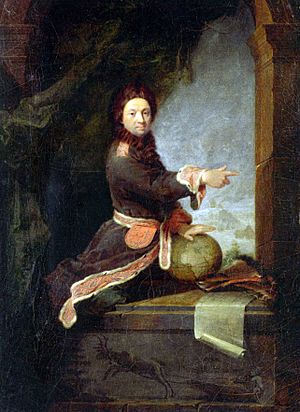Common descent facts for kids
Common descent means that different living things, like animals or plants, share a family connection. They all came from a single ancestor a long, long time ago. In evolutionary biology, this idea explains how groups of organisms are related.
Scientists have found proof that all life on Earth, from tiny bacteria to huge whales, came from one very first living thing. This first ancestor is called the Last Universal Common Ancestor (LUCA). In 2016, scientists even found 355 genes that likely came from LUCA. These genes are shared by almost all living things today.
When a new species forms, it usually comes from an older group of living things. This process is called speciation. Living things that share a more recent common ancestor are more closely related. The LUCA, the ancestor of all living things today, lived about 3.9 billion years ago.
The earliest signs of life on Earth are very old. They include graphite found in rocks in Greenland from 3.7 billion years ago. Also, microbial mat fossils were found in Western Australia from 3.48 billion years ago. All living things on Earth today share a common genetic history. This means they all descended from that single original species.
Contents
History of Common Descent
The idea of common descent is not new. People have thought about it for a long time.
Early Ideas
In the 1740s, a French mathematician named Pierre Louis Maupertuis had an early idea. He suggested that all organisms might have come from a common ancestor. He also thought they changed over time through random differences and natural selection.
Darwin's Contribution
The idea that all life came from a common ancestor through evolution was made famous by Charles Darwin. He was an English naturalist. Darwin wrote about this in his important book, On the Origin of Species, published in 1859.
How Humans Influence Evolution
Humans can show how much living things can change from a common ancestor. We do this through something called artificial selection.
Artificial Selection Explained
Artificial selection is when humans choose which animals or plants get to have babies. We pick the ones with traits we like. For example, a farmer might only breed the cows that produce the most milk. Over many generations, these chosen traits become stronger and more common. This process worked well even before scientists understood genes.
Dog Breeding

The many different kinds of dogs are a great example of artificial selection. All dog breeds, from tiny Chihuahuas to huge Great Danes, came from wolves. Humans chose wolves with certain looks or behaviors and bred them together. They wanted specific traits like color, fur length, or body size. This created all the different dog breeds we see today. Wild wolves, on the other hand, look much more alike.
Wild Cabbage
Farmers also used artificial selection to create many common vegetables. They all came from one plant called Brassica oleracea, or wild cabbage. Vegetables like cabbage, kale, broccoli, cauliflower, kohlrabi, and Brussels sprouts are all related to this wild plant.
- Brussels sprouts were made by choosing plants with large buds.
- Broccoli was bred by picking plants with big flower stalks.
- Cabbage was created by choosing plants with short leaf stems.
- Kale was bred by selecting plants with large leaves.
How Nature Influences Evolution
Nature also plays a big role in how living things change over time. This is called natural selection.
Natural Selection Explained
Natural selection is a process where traits that help an individual survive and reproduce become more common. Traits that make it harder to survive become less common. These helpful traits are passed down from parents to their children.
Darwin's Finches
When Charles Darwin studied the Galápagos Islands, he saw 13 different kinds of finches. These birds were closely related but had very different beaks. The beak of each species was perfect for the food available on its island. This suggested that their beak shapes changed over time because of natural selection.
For example, on islands where the main food was nuts, finches had large, strong beaks. These beaks helped them crack open nuts and get enough food. On islands where insects were the best food source, finches had slender beaks. These thin beaks helped them pull insects out of small hiding places.
See also
 In Spanish: Antepasado común para niños
In Spanish: Antepasado común para niños



